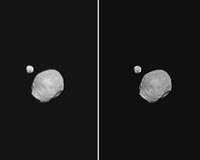 |
Pasadena CA (JPL) Sep 17, 2010 NASA's Mars rover Curiosity has been exercising its robotic arm since last month, when the arm was first fastened to the rover. In the long run, watch for this long and strong arm to become the signature apparatus of NASA's Mars Science Laboratory. After landing in August 2012, the mission will rely on it for repeated research activities. One set of moves crucial to the mission's success has never been tried before on Mars: pulling pulverized samples from the interior of Martian rocks and placing them into laboratory instruments inside the rover. Engineers and technicians are putting the arm through a range of motions this month in the clean room where Curiosity is being assembled and tested at NASA's Jet Propulsion Laboratory, Pasadena, Calif. "We're fine-tuning the ability to make the arm go exactly where we want it to go," said JPL's Brett Kennedy, cognizant engineer for the robotic arm. "Next, we'll start pushing on things with the arm." The arm can extend about 2.3 meters (7.5 feet) from the front of the rover body. Still to be added: the turret at the end that holds a percussive drill and other tools weighing a total of about 33 kilograms (73 pounds). "This arm is strong, but still needs to move accurately enough to drop an aspirin tablet into a thimble," Kennedy said. The titanium arm has two joints at the shoulder, one at the elbow and two at the wrist. Each joint moves with a cold-tolerant actuator, custom-built for the mission. The tools to be wielded by the arm include a magnifying-lens camera; an element-identifying spectrometer; a rock brush; and mechanisms for scooping, sieving and portioning samples. The mission is designed to operate on Mars for a full Martian year, which equals about two Earth years.
related report The goal of Curiosity, a rolling laboratory, is to assess whether Mars ever had an environment capable of supporting microbial life and conditions favorable for preserving clues about life, if it existed. This will help us better understand whether life could have existed on the Red Planet and, if so, where we might look for it in the future. 1. How Big Is It?: The Mini Cooper-sized rover is much bigger than its rover predecessors, Spirit, Opportunity and Pathfinder. Curiosity is twice as long (about 2.8 meters, or 9 feet) and four times as heavy as Spirit and Opportunity, which landed in 2004. Pathfinder, about the size of a microwave oven, landed in 1997. 2. Landing--Where and How: In November 2008, possible landing sites were narrowed to four finalists, all linked to ancient wet conditions. NASA will select a site believed to be among the most likely places to hold a geological record of a favorable environment for life. The site must also meet safe-landing criteria. The landing system is similar to a sky crane heavy-lift helicopter. After a parachute slows the rover's descent toward Mars, a rocket-powered backpack will lower the rover on a tether during the final moments before landing. This method allows landing a very large, heavy rover on Mars (instead of the airbag landing systems of previous Mars rovers). Other innovations enable a landing within a smaller target area than previous Mars missions. 3. Toolkit: Curiosity will use 10 science instruments to examine rocks, soil and the atmosphere. A laser will vaporize patches of rock from a distance, and another instrument will search for organic compounds. Other instruments include mast-mounted cameras to study targets from a distance, arm-mounted instruments to study targets they touch, and deck-mounted analytical instruments to determine the composition of rock and soil samples acquired with a powdering drill and a scoop. 4. Big Wheels: Each of Curiosity's six wheels has an independent drive motor. The two front and two rear wheels also have individual steering motors. This steering allows the rover to make 360-degree turns in-place on the Mars surface. The wheels' diameter is double the wheel diameter on Spirit and Opportunity, which will help Curiosity roll over obstacles up to 75 centimeters (30 inches) high. 5. Rover Power: A nuclear battery will enable Curiosity to operate year-round and farther from the equator than would be possible with only solar power.
Share This Article With Planet Earth
Related Links Mars Science Laboratory Project Mars News and Information at MarsDaily.com Lunar Dreams and more
 Don't Forget Deimos
Don't Forget DeimosSydney, Australia (SPX) Sep 13, 2010 Next year, Russia plans to launch a mission to Phobos, the largest moon of Mars. This spacecraft, called Phobos-Grunt, will be the first spacecraft to land on this moon, and also the first mission to return samples of Phobos to Earth. Phobos is an interesting object, and it's been studied a lot by orbiting spacecraft. The moon is in a fairly low orbit around Mars, which makes it easy to se ... read more |
|
| The content herein, unless otherwise known to be public domain, are Copyright 1995-2010 - SpaceDaily. AFP and UPI Wire Stories are copyright Agence France-Presse and United Press International. ESA Portal Reports are copyright European Space Agency. All NASA sourced material is public domain. Additional copyrights may apply in whole or part to other bona fide parties. Advertising does not imply endorsement,agreement or approval of any opinions, statements or information provided by SpaceDaily on any Web page published or hosted by SpaceDaily. Privacy Statement |